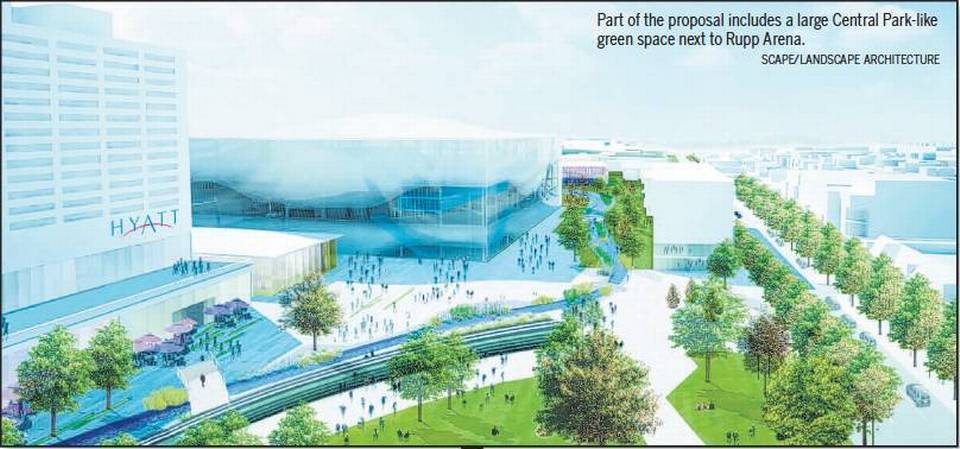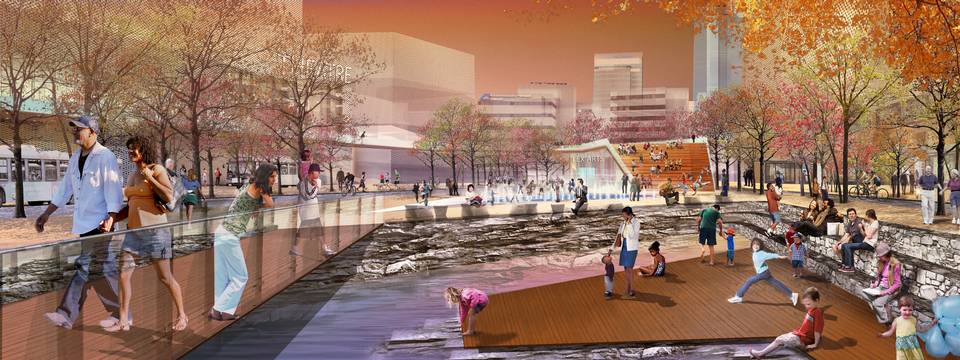By Beth Musgrave – bmusgrave@herald-leader.com
The row of asphalt parking lots behind the city’s government center and the Kentucky Theater along Vine Street provides parking but little else.
In 100 years, no one will remember it, said Jeff Fugate, president of the Downtown Development Authority.
Under plans for the Town Branch Commons, those asphalt lots could turn into green space with a water feature, benches and trees.
“Parks are long-term investments that shape investments for the next century,” Fugate said Friday.
Plans for the Town Branch Commons, a long linear park with a network of pools, fountains, rain gardens and pocket parks stretching from Isaac Murphy Memorial Art Garden to Cox Street, were unveiled in 2013 but were placed on hold while the city pursued a major overhaul of Rupp Arena and the attached convention center.

Part of the proposal includes a large Central Park-like green space next to Rupp Arena.

The linear Town Branch Commons project includes four sections. One of the proposed larger green spaces in the downtown linear park includes a park behind the Kentucky Theatre and the Urban County Government Center. That area is currently a series of asphalt parking lots.
With Rupp Arena plans stalled, the city is now turning its focus to Town Branch Commons.
The proposed park follows the path of Town Branch, a creek buried underground through downtown.
Mayor Jim Gray said in his State of the City speech last week that he would include money in his proposed budget in April for the project.
Gray said in an interview Friday that the city is still looking at a design by the firm Scape/Landscape Architecture to determine what portion of the park could be started first. The city is also still working on cost estimates. Scape, which was selected from five finalists in a design contest, has separated the plans into four sections that could be developed over time.
“We are still trying to determine what that first phase will be and are still in the process of doing cost analysis,” Gray said.
But Gray said private funding will be part of the overall Town Branch Commons financing plan.

“This is a transgenerational project that has enormous economic value,” Gray said. “It translates into a more livable and welcoming city where people want to live work and stay.”
The Downtown Development Authority is taking the lead in developing the park.
Fugate said many cities of similar size to Lexington are investing in parks because those green spaces create a unique sense of place. Across the country, nearly every new park that has been built has been built with a combination of private and public funds, he said.
Lexington doesn’t have to go far to find a model for a park system that works.
21st Century Parks, a Louisville nonprofit, has used a combination of private and public funding to plan and develop The Parklands, a series of four interconnected parks along Floyd Fork in Louisville. Two of the parks are already open, and the last two parks will likely open in 2016, said Dan Jones, the chairman and chief executive officer of 21st Century Parks.
Jones and 21st Century Parks are advisors on the Town Branch Commons project.
“It’s a high-quality plan that is architecturally exciting,” Jones said of Town Branch Commons. “It also responds to a lot of the needs in Lexington.”
The Louisville nonprofit started with a master plan in 2006 and will be finished with its interconnected park system by 2016. In that time, the group raised more than $70 million in private funding and more than $52 million from federal, state and local governments.
Jones said funding for parks was not a hard sell in a town that has benefitted so much from parks first conceived more than a century ago.
When world-renowned landscape architect Frederick Law Olmsted designed three parks — Cherokee, Iroquois and Shawnee — in the late 1890s, the parks were mostly on the outskirts of town. Now, Louisville has grown around those parks. Some of the most desirable neighborhoods in Louisville are close to those parks because people want to live next to green space.
For Louisville, the Olmsted parks have raised property values and created a specific sense of place.
“Parks shape a community well beyond the square of green space,” Jones said. “They can impact future development, the health and the well-being of the community.”
Funding Town Branch Commons will be a key hurdle, Jones said. Not only does the city need a plan to raise money for the park, but it will also have to think about how to support the park over time.
The good news: There is precedent for private investment in Lexington’s parks. The Triangle Foundation, a nonprofit of local and civic business leaders, was started in 1980 by local businessman Alex Campbell Jr. and other community leaders to build Triangle Park in the middle of downtown. The group has also paid for Thoroughbred Park on Midland Avenue and Main Street and the skatepark at Woodland Park.
Gray said he and the Triangle Foundation leaders have had some initial conversations about how the foundation might help with the development of Town Branch Commons.
“It’s a tribute to his leadership and vision that we have urban parks at all,” Gray said of Campbell.
Stephen Grossman, president of the Triangle Foundation, said the foundation has had some initial discussions with the city about how the group could help with the overall vision. But those discussions are still preliminary.
“I would like to see it come together,” Grossman said of the overall plan.
Fugate said that when completed the linear park would not only create a green space going through the city’s core but would also connect the city’s two main trails — the Legacy Trail and the Town Branch Trail. The plans also include a large park adjacent to Rupp Arena.
The idea of creating a linear park through downtown has been kicked around for some time. But through Scape’s plans, the city finally has a way forward, Fugate said.
There is a lot to do in coming months.
Gray will unveil his budget proposal to the Urban County Council sometime in April. The council has until July 1 to approve the budget. Many council members said after Gray’s speech last week that they supported the idea of the park but wanted to know more about the details.
“Moving from this vision to implementation will take time,” Fugate said. “We want to do it carefully, and we don’t want to do it in a vacuum.”
